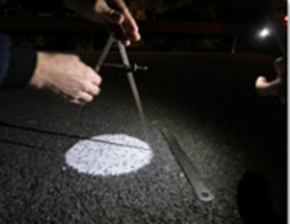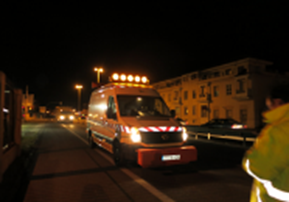First campaign
After implementing the demonstration projects, the first acoustic behaviour characterization campaign was conducted by means of the following indicators:
Sound indicators
- MCPX - Close ProXimity method. This method is standardized according to the ISO/CD 11819-2 Standard. “Acoustics. Measurement of the influence of road surfaces on traffic noise. Part 2: Proximity Method. This method consists of outside noise measurement from which the LCPX is obtained that allows road noise to be characterized. The noise levels are obtained by averaging three passes, with two microphones (front and back) on two lanes (left and right), and their value integrated every 20m of distance covered at the recorded speed.
- Statistical Pass-By Method (SPB - Statistical Pass-By Noise Test). This method is standardized according to the ISO 11819-1 Standard. “Acoustics. Measurement of the influence of road surfaces on traffic noise. Part 1: Statistical Pass-By Noise Method”. This method consists of measuring different noise events relating to vehicles passing by, characterized by level of sound pressure and pass-by speed. The number of vehicles moving at constant speed should be sufficient (around 100). Once registered, and after a subsequent analysis, a curve is obtained that presents the different events registered.
 |
 |
12. Tests: CPX (left) and SPB (right)
Auxiliary gauges directly relating to noise
Macro-texture measurements using the following methods:
- Volumetric method (sand circle): MTD (Mean Texture Depth). These measurements are taken according to UNE EN 13036-1. This method determines the average surface depth of a road surface by applying a known volume of material on to the surface and then measuring the total area covered.
- Profilometer method: MPD (Mean Profile Depth). These measurements are taken with a laser profilometer according to EN ISO 13473-1. The test consists of measuring the curve of a surface profile and of calculating the texture depth from that profile.
Surface regularity measurements using the Surface Regularity Index (SRI) obtained from the roadway’s longitudinal profile.
 |
 |
13. MTD macro-texture test (left) and auscultation vehicle (right), MPD macro-texture and SRI measurements
Once we analyzed the results obtained in this first acoustic assessment campaign, we confirmed that these types of LIFESOUNDLESS mixes succeed in reducing the road noise generated by the contact between the tire and the road surface. These are the principal conclusions:
- The expected noise reductions were achieved. The target set with the new LIFESOUNDLESS mixes was to achieve around 89-90 dBA at 50 km/h and 97dBA at 80 Km/h in the CPX test (reduction of 3dBA over the existing road surface before the action).
1. Gains obtained through the CPX test
|
ROAD |
COMPOSITION |
Average sound attenuation (dBa) |
||
|
50km/h |
80km/h |
|||
|
SET 1 |
A-8058 Seville to Coria |
SMA8 1% Scrap tires |
2,4 |
-- |
|
A-8058 Coria to Seville |
SMA8 1,5% Scrap tires |
4,6 |
-- |
|
|
SET 2 |
A-376 service road |
SMA8 0,5% Nylon |
3,9 |
-- |
|
A-376 Seville to Utrera |
SMA8 1% Recycled plastic |
4,7 |
7,3 |
|
|
A-376 Utrera to Seville |
SMA8 0,5% Recycled plastic 0,5% Scrap tires |
3,8 |
7,2 |
|
|
A-376 Utrera to Seville |
AC16 surf 35/50 S ref |
1,7 |
2,7 |
|
- The noise reductions measured with the SPB method are quantified at 5 dB on road A-8058 (Setting 1) and 9 dB on road A-376 (Setting 2).
2. Results of SPB measurements
| ROAD |
COMPOSITION |
TYPE OF VEHICLE |
Initial state |
1st Campaign |
|
|
LSPB(dBa) |
LSPB(dBa) |
||||
|
SET 1 |
A-8058 Seville to Coria |
SMA8 1% Scrap tires |
Light |
73,4 |
68,2 |
|
Heavy |
78,0 |
76,2 |
|||
|
SET 2 |
A-376 Utrera to Seville |
SMA8 0,5% Recycled plastic 0,5% Scrap tires |
Light |
77,2 |
68,3 |
|
Heavy |
80,7 |
72,5 |
|||
|
A-376 Seville to Utrera |
SMA8 1% Recycled plastic |
Light |
-- |
64,2 |
|
|
Heavy |
-- |
79,3 |
|||
- Acoustic variability on the paved sections is reduced from 2-3 dB (before) to 1 dB (after).
- The LIFESOUNDLESS mix, with the addition of 1% plastic (the mix spread in Setting 2: A-376) has achieved the greatest sound reduction. However, the most silent mix was the one containing 1.5% powdered scrap tires (the mix spread in Setting 1: A-8058), in part because it allowed more bitumen to be added to the mix.
 La consejería
La consejería
